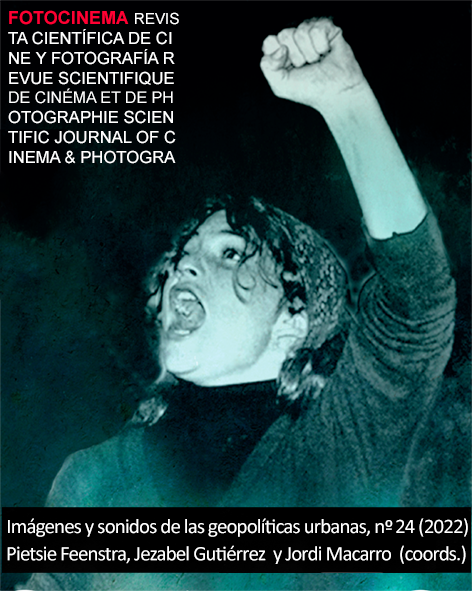Apocalyptic tension within three movies by Kurosawa Kiyoshi (Cure, 1997; Retribution, 2006; Pulse, 2001).
The specters of the dying city arise
DOI:
https://doi.org/10.24310/Fotocinema.2022.vi24.13672Keywords:
Cinema and city, modernity, apocalyptic cinema, fantasy cinema, ghosts, japanese cinemaAbstract
Given the fact that cinematography captured the first images in movement of the modern city, it would be poetically appropriate if it managed to arrive in time so as to capture the last images of its final stillness, right before its disappearance. In few filmographies like Kurosawa Kiyoshi’s can we perceive the continuity between modern city and imagery and contemporary city and imagery. Following the narrative of the last things, this article will focus on three of his movies; moreover, it will also focus on the progressive decay of the Tokyo that it is portrayed, until it reaches its ghostly disappearance. These movies are Cure (1997), Retribution (2006), and Pulse (2001). In these, Kurosawa enacts how our present would be when our modern cities -and the concept of modernity that he so well knows- are on the verge of their end. It will be, at this moment, when the viral infection of its ghostly façade becomes the biggest indication of its decadence.
Downloads
Metrics
Publication Facts
Reviewer profiles N/A
Author statements
Indexed in
-
—
- Academic society
- N/A
- Publisher
- Universidad de Málaga
References
Argullol, R. & Nivas Mishra, V. (2004). Del Ganges al Mediterra?neo. Un dia?logo entre las culturas de India y Europa. Madrid: Siruela.
Arnaud, D. & Hinstin, L. (2014). Interview with Kiyoshi Kurosawa about his double feature choices. Belfort: 29a edicio?n del Entrevues Belfort International Film Festival.
https://www.festivalentrevues.com/sites/default/files/images/archives/interview_kurosawa_hd.pdf. Consultado el 06/09/2018.
Benjamin, W. (2007). Pequen?a historia de la fotografi?a. Obras, libro II, vol. 1, 377-403. Madrid: Abada.
— (2008a). El Pari?s del Segundo Imperio en Baudelaire. Obras, libro I, vol. 2, 89-204. Madrid: Abada.
— (2008b). Parque central. Obras, libro I, vol. 2, 261-302. Madrid: Abada.
Barber, S. (2006). Ciudades proyectadas. Cine y espacio urbano. Barcelona: Gustavo Gili.
Bellour, R. (2013). El cuerpo del cine. Hipnosis, emociones, animalidades. Santander: Shangrila Ediciones.
Comolli, J-L. (2007). Ver y poder. La inocencia perdida: cine, televisio?n, ficcio?n, documental. Buenos Aires: Aurelia Rivera.
Darnton, R. (1968). Mesmerism and the end of Enlightment in France, Cambdridge: Harvard University Press.
https://archive.org/details/MesmerismRobertDarnton_201507, consultado el 09/10/2021.
Debray, R. (1994). Vida y muerte de la imagen. Historia de la mirada en Occidente. Paido?s, Barcelona.
Diccionario ilustrado latino-espan?ol espan?ol-latino (1964). Barcelona: Spes (6a ed.).
Eliot, T. S. (1999). Los hombres huecos. Poesías reunidas. 1909-1962. Madrid: Alianza.
— (2015). La tierra baldía. Prufrock y otras observaciones. Barcelona: Lumen.
— (2016). Burnt Norton. Cuatro Cuartetos. La roca y Asesinato en la catedral. Barcelona: Lumen.
Freud, S. (1974). Lo siniestro. Obras Completas, vol. 7. Madrid: Biblioteca Nueva.
— (1992) Lo ominoso. Obras completas, vol. 17, 215-252. Buenos Aires: Amorrortu.
Gautier, T. (1897). Romans et Contes. París: Alphonse Lemerre, editeur. https://fr.wikisource.org/wiki/Romans_et_Contes_de_The?ophile_Gautier/Jettatura, consultado el 10-10-2021.
Guzma?n Almagro, A. (2017). Fantasmas. Apariciones y regresados del ma?s alla?. Vitoria-Gasteiz: San Soleil Ediciones.
Kermode, F. (2000). El sentido de un final. Estudios sobre la teori?a de la ficcio?n. Barcelona: Gedisa.
Kristeva, J. (2004). Sobre la abyeccio?n. Poderes de la perversio?n, 7-47. Me?xico D. F.: Siglo XXI Editores.
Leutrat, J-L. (1999). Vida de fantasmas. Lo fanta?stico en el cine. Valencia: Ediciones de la Mirada.
McMullen, K. (1983). Ghost Dance [peli?cula]. Reino Unido: Looseyard LTD.
Pe?rez Ochando, L. (2013). Pozo de Sangre. Fantasmas del cine japone?s contempora?neo. La Laguna: Sociedad Latina de Comunicacio?n Social.
Soca, R. (2020). Morgue. La palabra del di?a,
https://www.elcastellano.org/envios/2020-09-09-000000. Consultado el 21-9-2020.
Straub, P. (2010). The Throat. Nueva York: Anchor Books.
Sebreli, J. (2013). El asedio a la modernidad. Cri?tica del relativismo cultural. Barcelona: Debate.
Tri?as, E. (1982). Lo bello y lo siniestro. Seix Barral, Barcelona.
Downloads
Published
How to Cite
Issue
Section
License
All contents published in Fotocinema Revista científica de cine y fotografía are protected under the Creative Commons Attribution-NonCommercial-ShareAlike 4.0 International (CC BY-NC-SA 4.0) license. All about this license is available in the following link: <http://creativecommons.org/licenses/by-nc-sa/4.0>
Users can copy, use, redistribute, share and exhibit publicly as long as:
- The original source and authorship of the material are cited (Journal, Publisher and URL of the work).
- It is not used for comercial purposes.
- The existence of the license and its especifications are mentioned.
There are two sets of authors’ rights: moral and property rights. Moral rights are perpetual prerogatives, unrenounceable, not-transferable, unalienable, imprescriptible and inembargable. According to authors’ rights legislation, Fotocinema. Revista científica de cine y fotografía recognizes and respects authors moral rights, as well as the ownership of property rights, which will be transferred to University of Malaga in open access. The property rights are referred to the benefits that are gained by the use or the dissemination of works. Fotocinema. Revista científica de cine y fotografía is published in an open access form and it is exclusively licenced by any means for doing or authorising distribution, dissemination, reproduction, , adaptation, translation or arrangement of works.
Authors are responsable for obtaining the necessary permission to use copyrighted images.














13.png)



